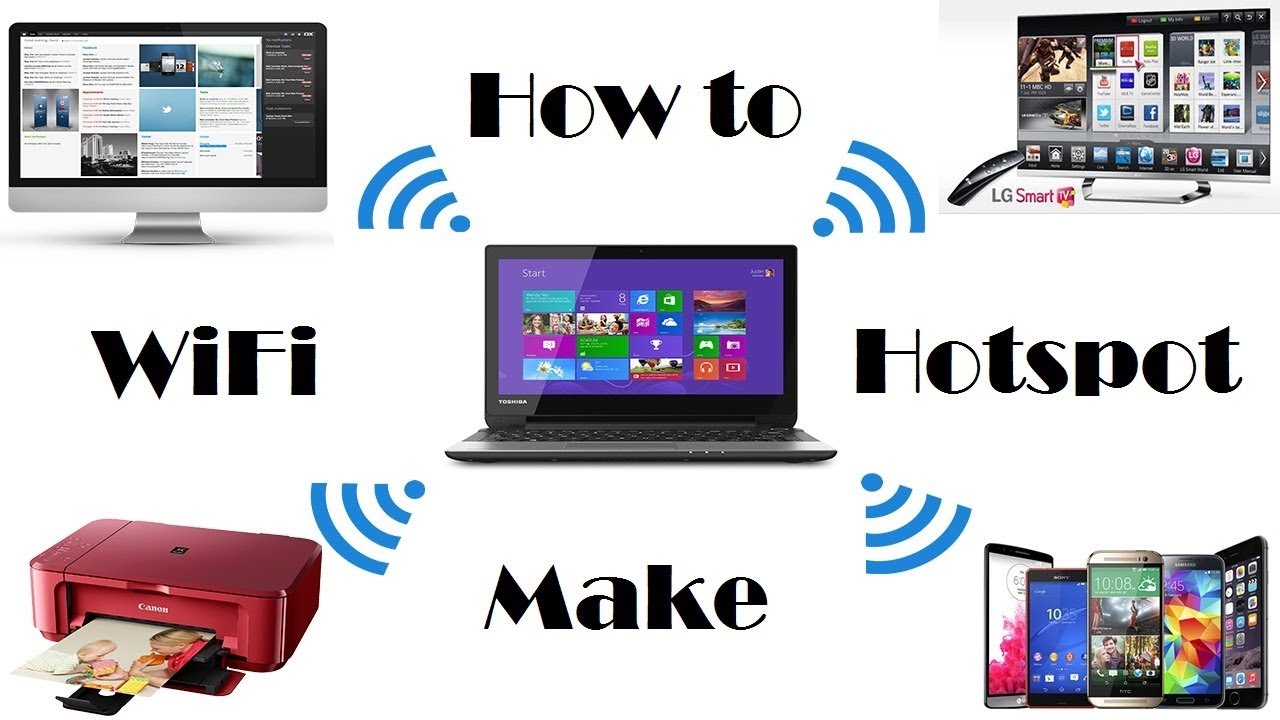Have you ever found yourself in a situation where there's a lack of Wi-Fi, and all you need is that internet connection to get some work done or stream your favorite show? Well, if you have a Windows 7 laptop, you're in luck! You can turn your laptop into a Wi-Fi hotspot. Sounds complicated? It’s actually quite simple! In this guide, I’ll walk you through the process step-by-step, so you can share your internet connection with your smartphone, tablet, or other devices in no time. Let's dive in!
Requirements for Transforming Your Laptop

Before we get into the nitty-gritty of creating your Wi-Fi hotspot, let’s gather everything you’ll need to make the process smooth and easy.
Here’s a quick checklist of requirements:
- A Compatible Laptop: Ensure your Windows 7 laptop has a wireless adapter. Most modern laptops do, but an occasional check won’t hurt!
- Working Internet Connection: This could be from Ethernet, another Wi-Fi network, or even a mobile broadband connection. Just make sure it’s running fine!
- Administrative Privileges: You need to be logged in with an administrator account since some settings require elevated permissions.
- Basic Knowledge of Command Prompt: Don’t worry if you're not an IT expert; just a willingness to follow instructions will suffice!
- Optional Software: While you can create a hotspot using built-in Windows features, third-party applications can simplify the process. Options like Connectify or mHotspot can offer user-friendly interfaces.
Now, let’s break this down a little further:
- Wireless Adapter:
Verify that your wireless adapter is functioning correctly. You can do this by going to Control Panel > Network and Internet > Network Connections. Look for entries related to your wireless connection. If it’s not there, you might need to update your drivers or consider getting a USB Wi-Fi adapter.
- Internet Connection:
Ensure your internet connection is stable. If you're using Ethernet, connect it to your laptop and make sure it's working by opening a web browser. If you are using another Wi-Fi connection, ensure you’re connected and can access the internet.
- Command Prompt:
To access the Command Prompt, you can search for it in the Start Menu. Make sure to run it as an administrator. This is where the magic happens as you enter commands to set up the hotspot.
- Optional Software:
If you choose to use a third-party application, make sure it’s from a reputable source and check user reviews before downloading. This can be a good choice if you prefer a GUI (Graphical User Interface) instead of command-line instructions!
Once you have everything in place, you’ll be ready to start creating your Wi-Fi hotspot. No more struggling to find Wi-Fi; you’ll be the hero among your friends and family! So, let’s proceed to the next steps where we’ll get everything working for you.
Also Read This: Mastering Video Searches on the Dailymotion App
3. Step-by-Step Guide to Set Up a Wi-Fi Hotspot
Setting up a Wi-Fi hotspot on your Windows 7 laptop is a great way to share your Internet connection with your friends or other devices. Here’s how you can do it step-by-step.
*Step 1: Check Your Network Adapter
Before diving into the hotspot settings, you need to ensure that your network adapter supports hosted networks. Here's how to check:
- Click on the Start button and type cmd in the search box.
- Right-click on Command Prompt and select Run as administrator.
- In the command window, type netsh wlan show drivers and hit Enter.
If you see a line that says "Hosted network supported: Yes", you're good to go! If not, you’ll need to consider updating your network adapter drivers or upgrading your hardware.
Step 2: Set Up the Hotspot
Now that we know the network adapter is up to the task, let's create the hotspot:
- In the same Command Prompt window, type the following command:
- Replace YourHotspotName with the name you want for your hotspot and YourPassword with a strong password (at least 8 characters).
netsh wlan set hostednetwork mode=allow ssid=YourHotspotName key=YourPasswordStep 3: Start the Hotspot
Once you've set it up, you need to start the hosted network:
- Type the command:
- Press Enter. You should see a message indicating that the hosted network has started successfully.
netsh wlan start hostednetworkStep 4: Share Your Internet Connection
Next, you need to share your laptop's internet connection with the new hotspot:
- Go to Control Panel and click on Network and Sharing Center.
- Click on Change adapter settings on the left sidebar.
- Right-click on your active Internet connection (like Wi-Fi or Ethernet) and choose Properties.
- Under the Sharing tab, check the box that says Allow other network users to connect through this computer's Internet connection.
- From the drop-down menu, select the virtual network adapter that corresponds to your hotspot (usually named "Local Area Connection xx").
- Click OK to save the changes.
Now your hotspot is up and running! Connect your devices using the hotspot name and password you've created.
Also Read This: How to Make Rose Hairstyle: Elegant Hairdo Tutorial on Dailymotion
4. Troubleshooting Common Issues When Creating a Hotspot
Even though setting up a Wi-Fi hotspot on your Windows 7 laptop is usually straightforward, sometimes things can go awry. Don't worry! Here are some common issues and how to troubleshoot them.
*Issue 1: Hosted Network Not Supported
If you found out that your adapter doesn’t support hosted networks, you might want to:
- Update your network adapter drivers from the manufacturer’s website.
- Consider using a USB Wi-Fi adapter that supports hosted networks, as they’re relatively inexpensive.
Issue 2: Connection Not Working
If your devices can see the hotspot but can't connect to it, try the following:
- Ensure the password you set is correct. It should be at least 8 characters long.
- Check if your laptop’s firewall is blocking connections. Temporarily disable it to test.
- Verify that your Internet connection is active before sharing it.
Issue 3: Hotspot Won't Start
If you’re having trouble starting the hosted network, consider:
- Running Command Prompt as an administrator again and retrying the commands.
- Restarting your laptop. This simple step can clear many issues.
Issue 4: Limited Connectivity*
If you’re experiencing limited connectivity when connected to the hotspot, try:
- Checking for any IP conflicts, especially if you have multiple devices connected.
- Rebooting both your router and your laptop.
If all else fails, a quick Google search or visiting forums can provide additional solutions. Don’t hesitate to reach out to tech-savvy friends or professionals! Hotspots are fantastic tools, and with a little patience, you’ll have yours running smoothly.
Also Read This: How to Make Cheese at Home in Urdu: Easy Recipe on Dailymotion
5. Benefits of Using Your Laptop as a Wi-Fi Hotspot
Turning your Windows 7 laptop into a Wi-Fi hotspot can be a game-changer, especially if you’re frequently on the go or working from different locations. Let’s explore some fantastic benefits of using your laptop in this way.
- Flexibility: You can access the internet anywhere you have a mobile data connection. Whether you’re at a cafe, library, or on a long train journey, you won’t have to rely on public Wi-Fi networks that may be slow or insecure.
- Cost-effective: If you have a mobile data plan, using your laptop as a hotspot can save you money. Instead of paying for additional data plans for multiple devices, you can connect your smartphone, tablet, or other laptops to a single connection.
- Improved Performance: Public Wi-Fi networks can often be slow or unreliable. By using your laptop as a hotspot, you can enjoy faster and more stable internet speeds, particularly if you have a good data connection.
- Easy Setup: Setting up a hotspot on your laptop is usually straightforward and doesn’t require complex configurations. With just a few clicks, you’ll be sharing your internet connection in no time.
- Multi-device Connectivity: You can connect multiple devices to your laptop’s hotspot. This means you can have your phone streaming music, your tablet browsing social media, and your friend's laptop online simultaneously without any hassle.
In a world where being connected is essential, having the ability to create a Wi-Fi hotspot from your laptop can empower you with greater internet access, convenience, and flexibility.
Also Read This: How to Make a Projector at Home with This Easy DIY Guide
6. Security Tips for Your New Hotspot
While using your laptop as a hotspot offers many advantages, it's crucial to keep your connection secure. Here are some essential tips to ensure that your hotspot is safe from potential threats:
- Set a Strong Password: Always use a complex password for your hotspot. Avoid simple or common passwords. A combination of letters, numbers, and special characters is ideal. For example, instead of "password123," try something like "p@s5w0rD!2023".
- Change Your Network Name: Don’t use default network names that could easily be associated with you or your device. Choose something unique that doesn’t reveal personal information.
- Use Encryption: Ensure that your hotspot uses WPA2 encryption. This adds an extra layer of security by encrypting your data and making it more difficult for unauthorized users to access your connection.
- Limit Access to Your Hotspot: Only share the hotspot with people you trust, and disable it when you’re not using it. Keeping the connection private helps prevent unwanted users from connecting.
- Monitor Connected Devices: Periodically check the list of devices connected to your hotspot. If you see something suspicious or unknown, disconnect it immediately and change your password.
By following these security tips, you can enjoy the benefits of your new hotspot while keeping your data and devices safe. A proactive approach to security is essential in this connected world, so don’t skip these crucial steps!
Also Read This: Master the Art of Creating Princess Cakes with Step-by-Step Videos on Dailymotion
7. Alternatives to Windows 7 Hotspot Creation
While creating a Wi-Fi hotspot on your Windows 7 laptop is a convenient solution, there are also several alternatives you might want to consider. Whether you're looking for ease of use, additional features, or greater flexibility, here are some noteworthy options:
1. Use Third-Party Software
There are many third-party applications designed to simplify the hotspot creation process. Some popular choices include:
- Connectify: This user-friendly software offers not only hotspot creation but also connection sharing management. It even allows you to customize your network name and password easily.
- mHotspot: A lightweight software that allows you to create a Wi-Fi hotspot in a matter of minutes. It's straightforward and supports multiple devices.
- Virtual Router Plus: This open-source router application is a great free option for creating hotspots. While it's simple to use, it lacks some advanced features found in paid alternatives.
2. Upgrade to a Newer Version of Windows
If your hardware supports it, consider upgrading to Windows 10 or 11. These newer versions have built-in hotspot capabilities that are generally more reliable and secure. The process is typically more straightforward, allowing you to share your internet connection with just a few clicks.
3. Use a Dedicated Mobile Hotspot Device
If you're regularly on the go or need a stable connection for multiple devices, investing in a dedicated mobile hotspot device might be a better option. These devices allow you to connect to cellular networks and provide Wi-Fi for your devices without draining your laptop’s battery. Plus, they often come with larger data plans that can offer better performance and coverage.
4. Use Your Smartphone as a Hotspot
Many modern smartphones have a built-in feature that allows them to function as Wi-Fi hotspots. You can typically find this feature in the settings menu under "Tethering" or "Mobile Hotspot." Just remember that using your smartphone as a hotspot can consume a significant amount of data, so keep an eye on your plan limits!
In summary, while creating a Wi-Fi hotspot directly through your Windows 7 laptop is a handy capability, these alternatives may provide enhanced functionality or ease of use. By exploring these options, you can find the best solution for your connectivity needs.
8. Conclusion and Final Thoughts
Transforming your Windows 7 laptop into a Wi-Fi hotspot can be a lifesaver when you need to share your internet connection with other devices. Whether it's for work, school, or simply staying connected while on the go, having this capability can make your life a lot easier.
As we’ve discussed, there are various methods to achieve this, from using built-in settings to leveraging third-party software. It’s essential to choose a method that fits your comfort level and the specific needs of your situation. If you encounter any obstacles, don’t hesitate to troubleshoot or consult forums; the tech community is very supportive!
On the other hand, if you're looking for more robust features or a more user-friendly experience, consider exploring the alternatives we discussed. Upgrading your operating system, using dedicated hotspot devices, or utilizing your smartphone can all provide viable solutions that might serve you better.
At the end of the day, the goal is to stay connected conveniently and reliably. Whichever route you decide to take, we hope this guide has helped you navigate the process and empowered you to turn your laptop into a useful hotspot. Happy surfing!
 admin
admin








